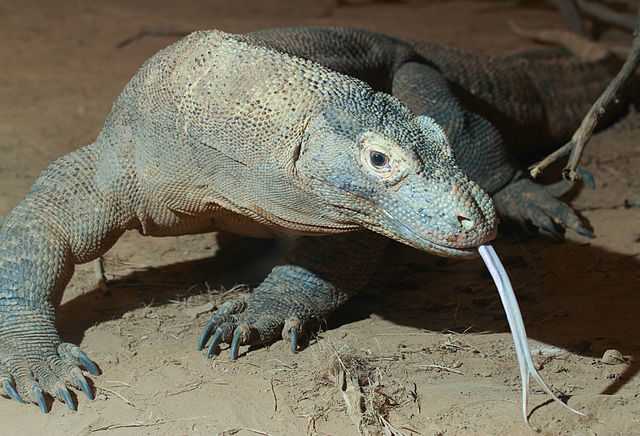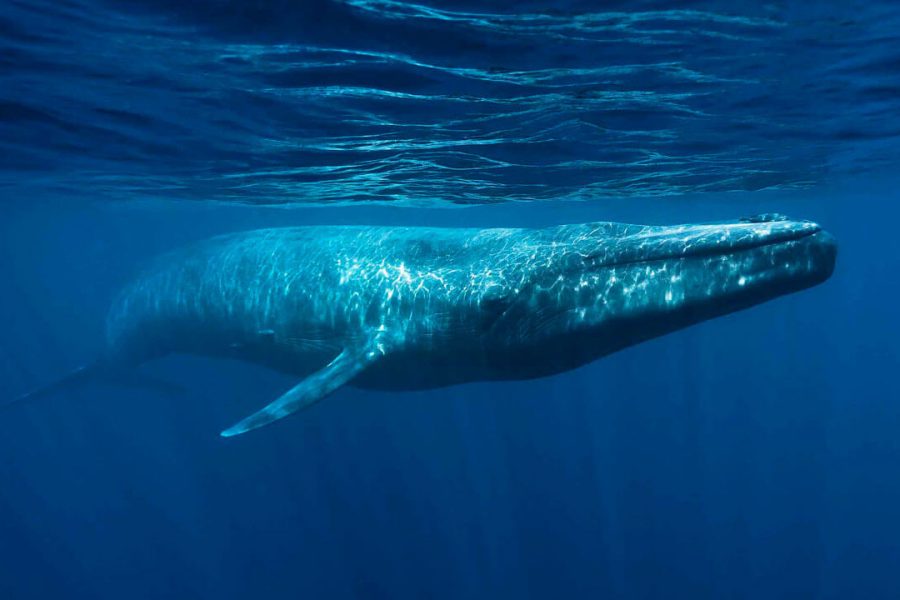Earth's magical ecosystems may be fading, but they're still full of amazing surprises—like these ten animal behaviors, each so opposite of what you'd expect they're practically oxymoronic.
10. Flying Squid
Often mistaken for flying fish, there are at least six known species of flying squid, and possibly dozens more. But since seeing them in action is the kind of spectacle that can happen in the blink of an eye, scientists have little to do. Most reports come from sailors who find them on deck in the morning.
But marine biologist Silvia Macia was lucky. While on holiday in 2001, she saw a torpedo-shaped Caribbean reef squid, alarmed by the noise of her boat, launch itself out of the water and arc through the air. Macia estimates it stood two metres tall and covered a distance of ten metres (50 times its own length). But it wasn’t just a leap. The squid “extended its fins and spread its arms radially in midair,” guiding its flight like an inside-out bird. As she and her husband later wrote in a paper with other biologists, “‘gliding’ is too passive a term for it; ‘flight’ is more appropriate because it suggests something active.” One of Macia’s co-authors even claimed to have seen squid flapping their fins like wings. They also shoot jets of water for extra thrust, sometimes with enough force to keep up with boats. Sometimes they can even be seen flying in flocks.
We don't know exactly why squid started flying, but it probably saves them energy when escaping from predators.
9. Walking bats
Although bats are mammals, they are so well adapted to flight that their "legs" do not allow them to walk. In most species, they are little more than "attachment points for the wing surface." Even crawling on the ground is an effort.
Of the 1,110 species of bats, only two have a true walk: the vampire bat and the smaller short-tailed burrower bat. For the vampire bat, walking is vital. After landing near sleeping prey, it must sneak up unnoticed to feed on its blood. One type of vampire bat can even run, using its wings for extra propulsion.
Less well known are the New Zealand burrowing bats, whose walking adaptations include grooves on the soles of their feet, clawed toes, and even pockets for storing wings. In fact, this species is so well adapted to walking that it spends 40 percent of its time foraging on the ground. But it can still fly as well as any other bat—unlike birds that are adapted to walking.
8. Bat-catching snakes
Since (most) bats can't walk and snakes can't fly, you might think they're not very closely related. But some snakes have actually taken to the air—or so to speak.
In a cave in the Yucatan rainforest, a population of yellow-and-red rat snakes has taken up residence in the ceiling cracks, clinging to bats. Given the dense flock of bats that emerge each night from the "Bat Cave," as locals call it, this behavior makes sense.
And, interestingly, they are not the only species to occupy this macabre niche. Over 1,000 kilometres away, across the Caribbean, boa constrictors snatch bats from the air and strike from the ceilings of caves. But even more astonishingly, they do so in packs, coordinating their positions to maximise their chances of getting a sip.
7. Fish-eating spiders

While some spiders are known to eat frogs, rodents, and birds, what kind of spider eats fish?
According to a review of the existing literature, this is not as unusual as it sounds. Species from five genera and from every continent except Antarctica are listed. In North America, semi-aquatic spiders catch small freshwater mosquitofish by attaching their hind legs to a rock or plant and "fishing" with their front legs on the surface of the water.
Once the catch is brought to land, feeding often takes several hours. Why does it take so long? Because on average, spiders spend at least twice as long catching fish as they do.
6. Bees cooking hornets

Stinging isn’t the only suicide attack used by nature’s bodhisattvas, the bees. When a hornet attacks a nest, hundreds of worker bees will huddle around the intruder to roast it alive with their body heat. Amazingly, this behavior, known as “defensive hot bee balls,” wasn’t documented until 1995, when it was studied in detail in Japan.
By rapidly vibrating their wing muscles for half an hour, bees can reach temperatures of 46 degrees Celsius, enough to kill a hornet in captivity. But while it's just below the frying point for bees, it appears to reduce the bees' lifespan. It also appears to disinhibit them neurologically, making them more likely to join the balls in the future than bees that have never participated.
Some species of bees may also use unheated balls to smother invaders, or dance in waves, flashing signals to warn potential attackers. Whatever they do, however, they must act quickly. Over time, the hornets release pheromones to attract reinforcements.
5. Sea spiders
You might think spiders would be wary of water. But many species live near it, and even in it. The so-called diving spider, for example, lives underwater in a silken base filled, bubble by bubble, with air from the surface. Once established, oxygen levels remain stable through diffusion from nearby aquatic plants.
What's even more surprising is that coastal spiders (Amaurobioides ) can travel by sea, which explains how they came to South Africa from South America during the Miocene. They also came to Australia and New Zealand. Using their legs as sails and silk as an anchor, shore spiders can travel around the world.
First described in 2015, this behaviour explains the mystery noted by Darwin of spiders blowing onto ships even miles from shore.
4. Komodo with the Immaculate Conception

In 2006, in a biological journalNature A bizarre report was published of two cases in which female Komodo dragons, both kept in zoos in England, reproduced without mating with a male. One laid 11 eggs, eight of which developed normally, while the other laid 22, four of which hatched. Since the second dragon had actually mated two and a half years earlier, researchers initially assumed she was simply holding sperm, as some reptiles can do. However, genetic analysis showed that her offspring were identical to her, only male. Meanwhile, the other dragon never mated.
Asexual reproduction, known as parthenogenesis, is extremely rare. Without sperm to provide the other half of her offspring's chromosomes, a mother simply duplicates her own. Only 0.1 percent of vertebrates are capable of this feat. Komodo dragons are thought to be unique to their isolated habitat, the islands of Indonesia, because parthenogenesis allows (at least in principle) females stranded on an island to start a new colony on their own.
Unfortunately, however, the offspring produced in this way, being genetically less diverse, are more susceptible to disease. They are also exclusively male, since, unlike humans, two identical chromosomes in Komodo dragons (namely ZZ) produce a male. So parthenogenesis is not really an advantage for this endangered species of monitor lizard.
3. Bird-catching fish
With the exception of sharks, relationships between birds and fish are almost always top-down. Fish don't catch birds out of the air.
Or did they? In 2014, a team of researchers in South Africa saw a tigerfish leap out of a lake and catch a swallow mid-flight. It happened so quickly that at first they weren’t sure what they’d seen. As it turned out, it was the first confirmed sighting of a freshwater fish hunting a bird in mid-air. And it wouldn’t be their last. Before leaving, the team had seen up to 20 such strikes every day. The anecdotal reports were true: Bird-hunting fish are common in the region, they’re just less well studied.
It happens elsewhere, too. Another species of bird-catcher is the silver arowana, a flying fish that hunts not only birds but also bats and even mice in what's left of the Amazon rainforest.
2. Land fish
Birds are not immune even to fish on land. On the Tarn River in Albi, France, there is a small island where pigeons come to clean themselves and catfish come to hunt them.
The European catfish is actually quite dangerous. They are usually between 1 and 1.5 meters long, but have been known to reach 3 meters, making them the largest freshwater fish on the continent. And despite their relatively “primitive” level of evolution, their great adaptability keeps them at the top of the food chain.
To track pigeons on land, the catfish swim nearby, picking up vibrations with their barbels (or “whiskers”) on their upper jaw. They then splash out of the water onto the island, snatching any pigeon that moves before diving into the deep. The whole thing takes less than four seconds.
1. Tree-climbing fish
Making even more of a mockery of the old adage “a fish out of water,” some species actually prefer it. By trapping water bubbles in their gill chambers, Asian mudskippers can breathe on land for up to two days, getting oxygen not only through their gills but also through their skin—as long as it’s moist. Specially adapted fins allow them to walk (or hop) on land, and even their vision is better on land.
But humans have known this for a long time. A recent discovery by scientists catching up with local knowledge is that some of them can climb trees, too. Darkgills and slender mudskippers are two species of tree-climbers. They use a combination of suction, friction, and slug-like secretions, as well as their fins, to shimmy vertically up tree trunks, according to researchers.
Even more astonishing, however, was their movement through water. Recordings of the dark-gill mudskipper in Java showed it jumping from vertical slopes, such as mangrove roots, onto water, and then from water onto another vertical slope on land. Using its body to propel itself, it reached speeds of 1.7 meters per second.













Оставить Комментарий